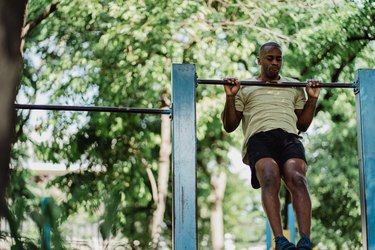







The last thing you want to do after a long exercise hiatus is return to your old routine like nothing has changed. Even if you're riding high on the thrill of being back in the gym, you need to ease back into things and not overdo it on day one.
To lower your risk of injury (and consequently, another unscheduled break from working out), there are a few moves you'll want to put on a temporary hold as you build your strength back up.
Video of the Day
Put a pause on these five exercises until you're back in your groove — and try these alternatives in the meantime.
Related Reading
1. Box Jump
One thing you want to avoid after a long break from fitness is high-impact exercise. Although plyometric (jumping) workouts are great for developing sport-specific skills and overall power, it's safer to steer clear of box jumps if you haven't worked out in a while, says Sam Chan, DPT, a certified athletic trainer and physical therapist at Bespoke Treatments in New York.
Plyometrics can be risky if you don't do them frequently and with the guidance of a professional, according to the American Council on Exercise (ACE). Sometimes the force sustained in plyo exercises can be as much as seven times your body weight, making them particularly taxing on the joints.
Swap It
Start with some easier plyo work like jumping rope or hopping drills, like speed skaters.
With time, progress to regular box jumps at a low height, increasing elevation gradually. Work your way up to full box jumps as you grow comfortable with the motion.
Speed Skater
- Start with your feet hip-distance apart.
- Jump to the side landing on one foot, letting your arms swing to that side.
- Quickly jump back the other direction, landing on the opposite foot.
- Repeat.
2. Triceps Dip
Triceps dips are a popular arm exercise, but they're probably a move you want to skip, exercise hiatus or not. This dip can put excessive stress on your shoulder joint, which can cause impingement (nerve pinching) and pain, according to the ACE.
Your shoulders rely on your muscles and tendons for stability during triceps dips. And while this move can be troublesome for anyone, it's especially risky if you haven't worked these muscles in a while.
Most people don't have the strength or stamina needed to perform the exercise properly.
Swap It
Stay safe and swap this exercise with an alternative triceps exercise. Chan recommends you start with triceps pushdowns, a safer and more effective triceps dip alternative.
Triceps Pushdown
- Begin holding a bar, rope or resistance band that's anchored high above your head. You can use a cable machine if you're at the gym.
- Keep your elbows bent and tight at your sides, slightly peeking behind your body.
- With your upper arms stable, straighten your elbows by moving your palms toward the floor, face down.
- After your elbows are fully extended, bend them again to 90 degrees, returning to the starting position.
3. Kipping Pull-Up
Even when you're in peak condition, kipping pull-ups are hard. "If you don't have the adequate conditioning or strength, the momentum and speed involved in this exercise mean your muscles may not be able to maintain control," Chan says.
Unlike regular pull-ups, kipping pull-ups involve momentum and a swing to bring your chest up to the bar, making them a cardio and power-based movement, in addition to strength. Plus, if you haven't done this move in a while, you run the risk of shoulder injury in this overhead position, Chan says.
Instead, start with lat pulldowns and pushdowns to re-introduce your upper body to the motion, he says. As you build your lat and trap strength increases, progress to strict pull-ups and barbell rows. Then, once your endurance and strength is where it was before your break, you can get back to the kipping pull-up more safely.
Lat Pulldown
- Set the height of the leg pads so that you can comfortably sit in the machine. Your legs should form 90-degree angles.
- Grab the overhead straight bar attached to the machine and grip it with your hands shoulder-width apart, palms facing away from you
- Bend your elbows and pull the bar into your chest, leaning back very slightly.
- Then, reach up until your elbows are straight to complete the rep.
4. Upright Row
Upright rows put your shoulder in an internally rotated position, facing your body, Chan says.
This motion compresses the tendons and muscles in your rotator cuff, putting you at higher risk of shoulder impingement and pain — especially if you haven't trained your shoulders in a while.
Swap It
Cable face pulls and scaption raises work your shoulder muscles and traps in an external or neutral position, decreasing the risk of shoulder impingement, Chan says.
As you progress toward the full upright row, practice internally rotating your shoulders without resistance to reintroduce the motion to the joint. You can prep for upright rows with a broomstick, focusing on rotating the shoulders toward the body with each rep.
Resistance-Band Face Pull
- Start by anchoring a cable machine or resistance band at about eye height.
- Stand a foot or two away from the anchor, holding the band or rope cable attachment in each hand with an overhand grip, thumbs facing toward you.
- Lead with your elbows up at shoulder height, pulling the rope toward your chin, fists at eye level.
- Hold here for a moment.
- Then, release and return to the starting position.
5. Barbell Deadlift
The deadlift is an excellent compound exercise that works nearly all major muscle groups in your body . But if you're just getting back to deadlifts, you shouldn't start pulling at your previous level, Chan says. Barbell deadlifts are a challenging progression, so you should treat the move as if you were a newbie.
Swap It
Start with a kettlebell deadlift to re-familiarize yourself with the hip-hinge motion. Kettlebells help you practice the correct movement pattern and mechanics without overloading your lower back, which you risk doing if you start with a more challenging progression.
Additionally, before you deadlift, take your body through a dynamic warm-up and choose a weight that's at most 75 percent of your previous norm.
Kettlebell Deadlift
- Stand with your feet hip-width apart and place a kettlebell between the arches of your feet.
- Hinge from your hips, softening your knees as your hips sink enough to hold the kettlebell horns with both hands. Your shoulders should be above your hips, and your hips above your knees. Check your posture: Your spine should be straight and long, chest up and open.
- Brace your core to maintain this position as you push your feet into the floor, as if you were trying to push the floor away from you using your glutes and hamstrings, to pull the kettlebell up and return to standing.
4 Tips to Ease Back Into Exercise
1. Start Slowly
No one enjoys backtracking, but sometimes the fastest way forward includes a step back. Keep your intensity low when you first get back and decrease the weight you're lifting. Lifting about 75 percent of your previous weight is generally safe, Chan says, but start even lower for the first few reps of each exercise.
2. Leave Reps in Reserve
"There's no need to immediately jump back into sets to failure your first workout back," Chan says. "Your body needs time to ramp up and re-adapt to training." With every set you perform, stop a few reps short of your maximum.
3. Start With Moves You Know
Always start with exercises you're comfortable performing. If you've been squatting for several years and take a six-month break, the movement pattern can come back to you pretty quickly. Conversely, if the form is unfamiliar, it's best to start from scratch and re-learn the motion.
4. Warm Up and Cool Down
To stay free of injury, take your body through a warm-up and cooldown routine before and after every workout. Even starting with a few rounds of cat-cow pose and ending with runner's lunges can make a huge difference. These routines can ensure your muscles are ready for your training session.
Was this article helpful?
150 Characters Max
0/150
Thank you for sharing!
Thank you for your feedback!